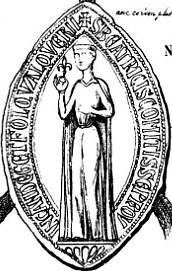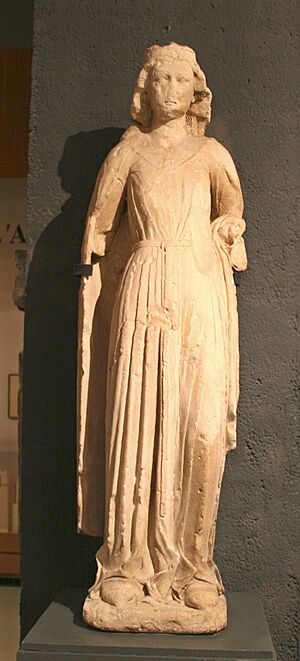Beatrice of Provence facts for kids
Quick facts for kids Beatrice of Provence |
|
|---|---|

Beatrice holding fleur-de-lis, as shown on her seal
|
|
| Countess of Provence and Forcalquier | |
| Reign | 19 August 1245 – 23 September 1267 |
| Predecessor | Raymond Berenguer IV |
| Successor | Charles II |
| Queen consort of Sicily and Naples | |
| Tenure | 26 February 1266 – 23 September 1267 |
| Born | c. 1229 |
| Died | 23 September 1267 (aged 37–38) |
| Spouse | |
| Issue more... |
Beatrice, Latin Empress Charles II, King of Naples Philip Elizabeth, Queen of Hungary |
| House | Barcelona |
| Father | Ramon Berenguer IV, Count of Provence |
| Mother | Beatrice of Savoy |
Beatrice of Provence (around 1229 – 23 September 1267) was an important ruler in medieval Europe. She was the ruling Countess of Provence and Forcalquier from 1245 until her death. She also became Countess of Anjou and Maine, and Queen of Sicily and Naples through her marriage to Charles I of Naples.
Beatrice was the fourth and youngest daughter of Ramon Berenguer IV, the Count of Provence and Forcalquier. Her mother was Beatrice.
Contents
Life of Beatrice of Provence
Becoming Countess
Beatrice and her sisters were known for their beauty. People said she was so charming that she inspired poets and made men's hearts race.
Beatrice had three older sisters who all married powerful rulers:
- Her oldest sister, Margaret, became Queen of France. She married King Louis IX.
- Her second sister, Eleanor, became Queen of England. She married King Henry III.
- Her third sister, Sanchia, became the Queen of Germany (in name only). She married Richard, Earl of Cornwall, who was King Henry III's brother.
King Louis IX's mother had hoped that Provence and Forcalquier would become part of France when Beatrice's father died.
However, in his will, Beatrice's father, Ramon Berenguer IV, made a surprising choice. He left the Counties of Provence and Forcalquier to his youngest daughter, Beatrice, who was still unmarried. This happened on June 20, 1238.
Ruling Provence and Forcalquier
Ramon Berenguer IV died on August 19, 1245. According to his will, Beatrice became the Countess of Provence and Forcalquier. Her mother, the Dowager Countess, was allowed to use the income from Provence during her lifetime.
Beatrice quickly became one of the most desired unmarried women in Europe. Many powerful men wanted to marry her.
- Raymond VII, Count of Toulouse, a neighboring ruler, wanted to marry her.
- James I of Aragon, another king, even invaded Provence to try and claim her.
- Frederick II, Holy Roman Emperor, sent his navy to Provence. He wanted to make sure Beatrice married one of his sons.
Beatrice's mother acted quickly to protect her daughter. She took Beatrice to a safe castle in Aix and gained the trust of the local people. Then, she asked Pope Innocent IV for help.
In December 1245, a secret meeting took place in Cluny. The Pope, King Louis IX of France, his mother Blanche of Castile, and Louis's youngest brother Charles were all there. They decided that Charles would marry Beatrice. In return, King Louis IX would support the Pope in a military fight against Emperor Frederick II.
Beatrice and her mother were happy with this plan. However, there was a special rule: Provence would never become part of France directly through Charles.
- If Charles and Beatrice had children, the Counties would go to them.
- If they had no children, Provence and Forcalquier would go to Sanchia of Provence.
- If Sanchia also died without heirs, the Counties would go to the King of Aragon.
King Henry III of England was not happy with these terms. He argued that he hadn't received all the money promised for his wife Eleanor's marriage. He also still held castles in Provence as payment for a loan he had given to Beatrice's late father.
Charles, along with 500 knights, rode to Provence. On their way, they met Raymond VII of Toulouse, who was also heading to Provence with his army. Charles's army was faster. When Charles reached Aix-en-Provence, King James I of Aragon had already surrounded the castle where Beatrice and her mother were. After a short struggle, the King of Aragon left.
Beatrice found Charles to be a good solution to her problems. They married on January 31, 1246, in Aix-en-Provence. Soldiers guarded the wedding, and Beatrice was walked down the aisle by her uncle, Thomas, Count of Flanders.
Beatrice's inheritance caused problems with her older sisters. They believed their father's lands should have been divided among all four of them. Charles refused to share the Counties with his sisters-in-law. Because of this, the relationship between Charles and Beatrice and her three sisters was always difficult.
As soon as Charles became Count of Provence, he brought in his own French lawyers and accountants. He took power away from the local nobles who had been quite independent. Charles became very unpopular. Beatrice's mother moved to Forcalquier to protest. In Marseille, Charles's officials were even forced out of the city. During these family conflicts, Beatrice supported her husband.
The Seventh Crusade
In May 1247, Charles was made a knight by his brother King Louis IX. Beatrice went with Charles on the Seventh Crusade in 1248. This was a long journey through France, led by King Louis IX. Before they left, Charles and Beatrice met with Beatrice's mother to discuss Provence. They agreed that Beatrice's mother would give up her rights to the castle at Aix for a share of the county's income.
In Nicosia, Beatrice gave birth to her first child, a son. Sadly, the baby lived only a few days. Later, in Damietta, Beatrice gave birth to her second child. In 1250, they met up with the rest of the crusaders in Acre. Charles and Beatrice then traveled to meet Emperor Frederick II. They asked him to send more soldiers for the crusade, but the Emperor refused.
Beatrice and Charles returned to Provence in 1251. Some riots broke out in Arles and Avignon. Beatrice's mother had encouraged these riots because she felt Charles had not respected her claims in Provence. By July 1252, Charles had stopped the revolt and was fully in charge of Provence.
In November 1252, Blanche of Castile, who was ruling France while her son King Louis IX was on crusade, died. Charles and Beatrice had to go to Paris, where Charles became a co-ruler of France with his brother, Alphonse. The Pope offered Charles the Kingdom of Sicily in 1252. However, Charles had to refuse because he was busy with other matters and didn't have enough money.
The crusaders returned in 1254. Charles and Beatrice spent Christmas in Paris that year. All of Beatrice's sisters and their mother were there. It was noticed that the older sisters treated Beatrice coldly because of their father's will.
Becoming Queen of Sicily
In 1259, Beatrice's sister Margaret, who was now the Queen of France, publicly insulted her. Margaret did not let Beatrice sit at the main family table. She said Beatrice was not a queen like her sisters, so she couldn't sit with them. Margaret hoped to make Beatrice angry enough to do something wrong, which would give Margaret a reason to invade Provence. Beatrice was very sad and told Charles what happened. He reportedly told her, "Don't worry, for I will soon make you a greater Queen than them."
Later, the new Pope Clement IV offered Charles the Kingdom of Sicily. To get the throne, Charles had to defeat King Manfred, whom the Pope no longer supported. Another person who wanted the Sicilian throne was Beatrice's nephew, Edmund Crouchback. But it became clear that Charles was a better choice.
To achieve his goal, Charles needed an army. Beatrice helped her husband raise one. She called on her knights and young men from France to join her husband's army. It is said that she even sold all her jewels and personal treasures to help pay for the army. Her efforts attracted many brave young men to her husband's cause.
In 1265, Charles of Anjou sailed to Rome. On June 28, the Pope made him King of Sicily. Beatrice followed her husband by sea with the rest of the army. She arrived in Italy four months later. In November of that year, Charles's army, made up of 5,000 soldiers and 25,000 foot soldiers, entered Italy. They arrived in Rome in January 1266. On January 6, Charles and Beatrice were crowned King and Queen of Sicily by five cardinals sent by the Pope.
After the coronation parties, Beatrice stayed in Rome with a small group of soldiers to protect the city. Charles rode off to the Battle of Benevento. After her husband won the battle, Beatrice chose the castle of Melfi as their home.
Death
Beatrice died on September 23, 1267, just over a year after becoming queen. She died in either the Castello del Parco at Nocera Inferiore or in Naples. The reason for her death was not written down, but some people think it was due to problems after a pregnancy.
She was first buried at the Cathedral of San Gennaro in Naples. But in 1277, her husband moved her remains to Aix-en-Provence, to the Church of Saint-Jean-de-Malta.
Beatrice was the last ruling Countess of Provence and Forcalquier from the House of Barcelona. When she died, she left her Counties to her husband Charles.
Children
Charles and Beatrice had the following children:
- Blanche (born 1250 – died before January 10, 1270). She married Robert of Flanders in 1265. They had one son, Charles, who died young.
- Beatrice (born 1252 – died November 17 or December 12, 1275). She married Philip of Courtenay in 1273. They had one daughter, Catherine I of Courtenay.
- Charles II (born 1254 – died May 6, 1309). He became Count of Anjou and Provence, and King of Naples. He married Maria of Hungary and had children.
- Philippe (born 1256 – died January 1, 1277). He was the King of Thessalonica (in name only) from 1274. He married Isabella of Villehardouin in 1271.
- Robert (born 1258 – died before May 9, 1265).
- Isabelle (born 1261 – died October 1303). She married Ladislaus IV of Hungary. They did not have children.
Many famous people are descendants of Beatrice and Charles, including Yolande of Aragon, Philippa of Hainaut, Isabella I of Castile, Henry VIII of England, Caroline of Ansbach, Queen Victoria and Elizabeth II of Great Britain.
See also
 In Spanish: Beatriz de Provenza para niños
In Spanish: Beatriz de Provenza para niños


